Spider Plant Not Growing? Try This!
Is your spider plant staying small and not growing as you thought it would? In this blog, we will share some cool tips to help your spider plant start growing again.
If you are among those who are wondering why your spider plant is not growing, then you are at the right place. Today we shall discuss all about growing spider plants and what affects the growth of the plant.
Inadequate watering and temperature fluctuation are the primary causes of stunted growth in spider plants. Apart from these, low lighting and pest infestations can also affect the spider plant’s growth. Providing adequate care and a balanced environment can help with the growth of the plant.
There could be multiple reasons for your spider plant not growing, and in this guide, we will talk about why the spider plant is not growing and how we can help it. Let’s get started!
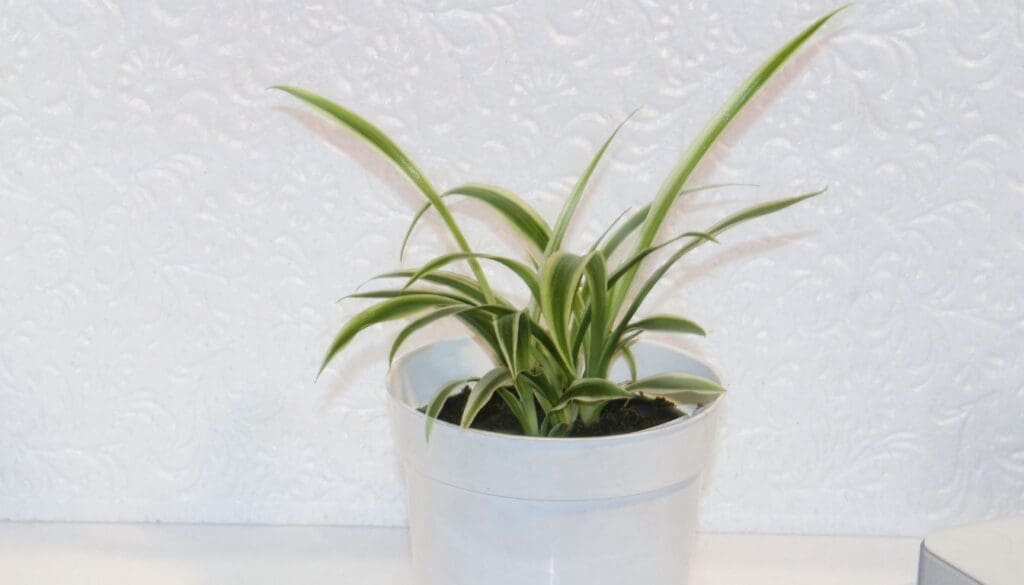
Please note: Simplify Plants is reader-supported. Some links in the post are affiliate links and I get a commission from purchases made through links in the post.
Why is my Spider plant not growing?
The most important things to check if the spider plants are not growing could be anything like the watering or the light conditions.
It could also be that the spider plants are not producing babies or runners that make the plant bushy.
Some of the most common factors that can be noted are:
- Time of the year
- Watering
- Type of potting soil used
- Light conditions
- Temperature and humidity
- The size of the pot
Let us get into some depth regarding the topic and find out how these problems can affect our spider plant’s growth and what we can do to fix these problems.
1) How the Time of Year Affects Spider Plant Growth

We must understand that the time of the year for the spider plant’s growth differs slightly from other plants.
We have already talked about why the spider plant growth is so impressive.
This lovely plant produces spider pups, which can further be propagated and kept in a pot. The spider plants can multiply rapidly, but it is always to you to choose.
The spider plants should be growing the spider pups around February to late March. We will notice little spider plants along with the mother plant.
During the spring season, we will notice the growth of these little spider plants. These are known as the pups.
We must take care of the spider plant for at least two more months until the summer season starts.
Once the summer starts, the spider plants will bloom and blossom again. However, extreme heat is one possibility of no growth in the plant.
Suppose we do not see the pups growing. In that case, there could be some other issues in the watering or fertilization, which we will cover in the coming topics.
2) The Impact of Watering Habits on Spider Plant Growth
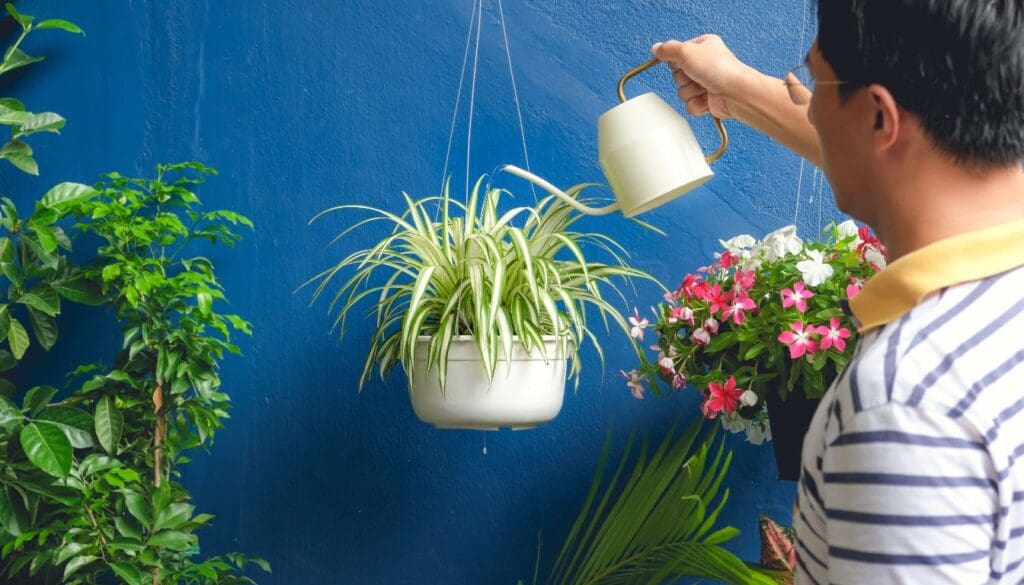
Watering of the spider plant could get a bit tricky if we neglect the plant. The spider plant does not like to be overwatered, nor does it like to be underwatered.
The plant is straightforward to care for and thrive for up to 10 days without being watered. However, there are certain things that we should understand. Let’s find out what it is!
Underwatering of the Spider plant
The spider plant is neither succulent nor a tender plant. The spider plant is native to tropical regions and is mostly distributed in Africa.
The spider plants can be without water for a week and a half, and we should not stress the plants further.
However, we will follow the golden rule here. Always feel the soil before we water the spider plants.
The soil should be dry and not moist.
If the spider plant is underwatered, then we will see the spider plant start to wilt and droop.
Also, the color of the leaves will change to yellow and might develop a tan.
Another point to consider here is the season, as we had mentioned above.
Although we do not water the spider plants daily, we need to regularly examine the plants.
Yes, that’s correct. When we notice the pups on the spider plants, we should water them before they get too dry, as these pups require moisture for survival.
This way, the spider plants will be healthy and continue to show signs of positive growth.
Overwatering of the Spider plant

The most common mistake is the overwatering of the spider plants.
Remember, we should not keep the soil soggy all the time and let the soil dry out before watering the plant. The best way to avoid this is by touching the soil.
Another critical factor that we will consider is the drainage system. The drainage has to be suitable for the spider plant because otherwise, they will develop root rot.
The root rot situation should be avoided at any cost, as they also send an invitation to the pest.
If the plant is overwatered, then the spider plants will start to turn brown. We need to avoid the plant turning brown.
How to avoid overwatering?
We can avoid the overwatering situation by:
- Always feel the soil before watering the spider plant
- While feeling the soil, it should be dry and not moist
- Check for drainage holes.
- If found blocked, clean the drainage holes
- Excess water in the drainage tray should be removed
- Use a well-draining potting soil mix
- Make a watering regime
- Keep a reminder or attach a note to the plant
During winter, the spider plants enter the dormancy period and require very little water.
Here are a few tips for watering
The spider plants are very picky with the type of water. It is often found that the water available in the house has more salt content or more fluoride.
The excess content of fluoride and salt will cause the spider plants to turn brown and rusty, and we might as well notice gray tips.
To avoid this situation, we must distill the water by boiling it. We will boil the water and return it to room temperature before watering the spider plant.
Heating the water will remove the excess minerals from the water, and it will not cause any mineral boom.
Also read: Overwatering vs Underwatering.
3) Choosing the Right Potting Soil for Optimal Spider Plant Growth
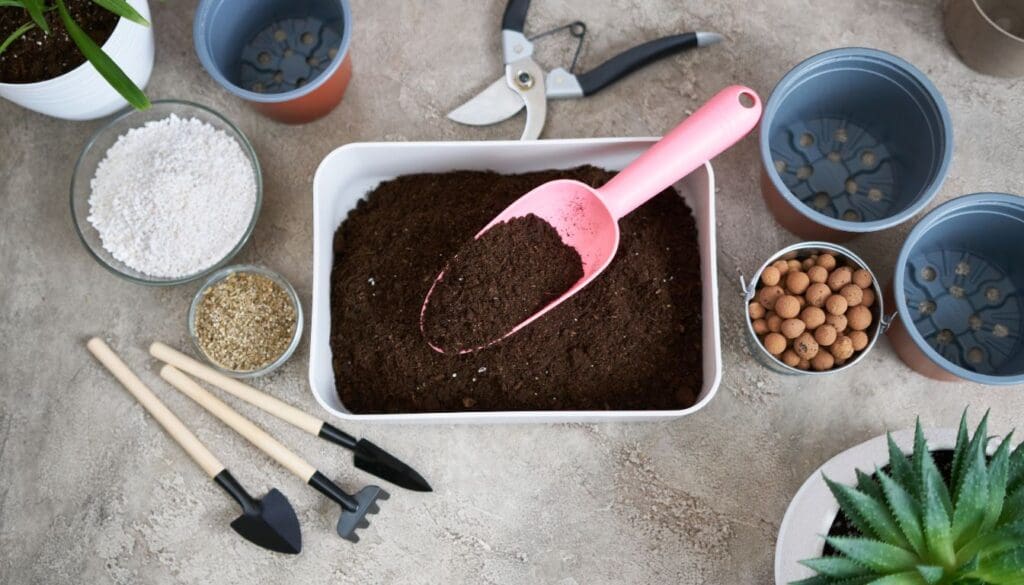
The spider plant needs well-draining potting soil because the spider plant species can be overwatered easily.
The spider plants love to stay in a small-sized pot where they can root tightly, and we should not repot unless we can see the roots popping out from the drainage holes.
To provide the plant with a well-draining and well-aerating soil, we can add some moss to the soil.
Often, repotting is also not required. Instead, we can just add some extra soil to the pot because some soil could be lost due to watering.
The addition of coco-peat will help retain the moisture.
If nothing works, then we will need to repot the spider plants in a different pot. To repot a spider plant, we will need:
- A new pot
- A well-draining potting soil
- Coco-peat or some moss
- Compost for the nutrients in the soil
First, remove the plant from the older pot gently and keep the plant along with the root ball under running water.
Take the new pot and add some well-draining potting soil mix along with some compost.
Compost helps take care of the micronutrient and the macronutrient that is needed by the plant.
Then place the spider plant in the middle of the pot and cover it with soil.
Be very gentle during this process. We do not want to hurt the roots.
Now, cover the spider plant with some more soil. We can also add some coco-peat to the soil for some additional moisture.
Coco-peat helps with better air circulation in the soil. Because the soil is airy, the plant will develop its growth quickly.
It also helps with increasing the water-holding capacity of the potting mix.
We can also add some moss after the plant is placed and covered with the extra soil.
Once this process is over, gently tap the pot to remove any air pockets formed.
Finally, water the plant.
Spider plants love to be around different temperatures and enjoy seasonal changes. Hence, we suggest keeping it near a window with good air circulation.
Also, keep the spider plant away from direct sunlight. They love bright indirect sunlight.
The repotting will ensure that the spider plant comes back to normal. Once the plant is hydrated and healthy, we might notice the spider plants grow.
Also read: What kind of soil is good for spider plants?(Perfect soil mix)
4) The Influence of Light Conditions on Spider Plant Growth
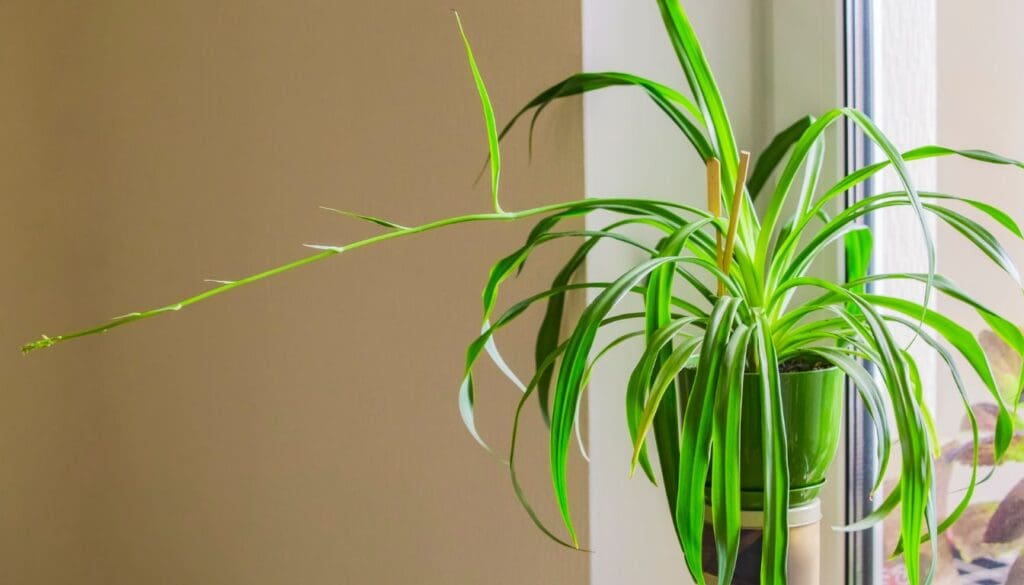
The spider plant needs light as much as other plants need. The plants require perfect light conditions for photosynthesis.
Light conditions preferred by the spider plants are mostly bright indirect sunlight. They thrive best in bright indirect light.
If the spider plants are placed under direct sunlight, then the spider plants will develop a burn, and we can notice the signs of brown tips and edges.
Hence, always keep the spider plants behind a curtain or a partial shade when keeping near the bright light.
The light condition, if not perfect, will halt the growth of the spider plant. This also affects the variegation and the color of the leaves.
If the spider plant is kept under direct light, the shades of the leaves will be darker, but the leaves will burn.
However, if kept in a perfect light condition with optimum light, then we will notice the spider plants developing perfect variegation.
If you cannot provide natural light, then we can also use artificial light.
Also read: How much light do spider plants need?
5) The Role of Temperature and Humidity in Spider Plant Growth Rate
The spider usually sees slow to no new growth when the temperature level drops below 15°C.
If we see that the spider plants have not grown at that point, it very well may be throughout the colder time of year, when the plants experience a cool draft.
Consider keeping the spider plant away from the cool draft, as they can’t endure winter.
We ought to try not to utilize the southern window.
Humidity could be another possible cause of stunted growth in spider plants.

We need to use a humidifier around the spider plant throughout the year.
Don’t worry about the pest problem that can occur due to high humidity because we can always spray some neem oil to keep most of the pests at bay.
Keep the spider plants away from the radiators during winter, and places like the washroom help for that additional moisture.
Spider plants are often seen wilting and not growing if the plant experiences sudden temperature changes as well.
Often during summers, when kept in an air-conditioned room, it might get colder during the night, and the spider plant might get stunted growth.
It is always suggested to keep and relocate the spider plants. They need proper air circulation for gentle growth.
Even though the plant doesn’t require additional moisture, a bit of misting and using a humidifier will benefit the spider plant.
6) How the Size of the Pot Can Limit Spider Plant Growth
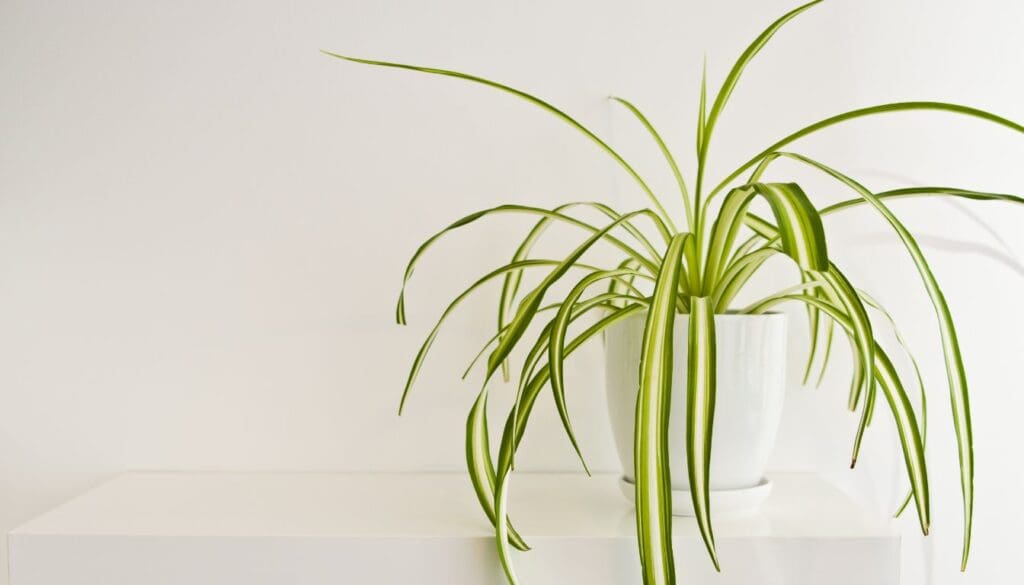
The size of the pot assumes a significant function in the development of the plant. If the pot is too big, the chances of overwatering are high.
On the off chance that the pot is small, at that point, the roots will grow totally in the pot and will stop the development of the plant at one point.
This might also result in the plant’s stunted growth and cause the spider plant to halt its growth.
The spider plants prefer smaller pots and can be slightly root-bound. Only when the roots are visible from the drainage holes should we consider a repotting of the spider plants.
The roots of the plant need space to develop. Thus we generally move the plant to a larger pot once the plant has built up the roots.
If the spider plant is repotted quickly, we will notice that the spider plants are not growing because the plant roots do not develop completely.
It is an overall principle that if our plant is 1 foot in stature, at that point, we need a 2-gallon pot, and on the off chance that the plant is 2 feet in tallness, at that point, a three-gallon pot will be required, etc.
Accordingly, check for the roots of the plant. The roots should be grown totally, and once created, it is the ideal opportunity for a repot.
Also read: What happens when you keep a plant in too big of a pot?
Final Words

The spider plant is one of the easiest plants to care for, and we need not worry about this sturdy plant much.
Be careful with the fertilization as they require a very light dose of a balanced fertilizer.
Just be careful and do not over-fertilize. Also, these plants can be fertilized every two weeks during the growing season only.
You might face a bit of difficulty during the winter months. Still, once the spring season kicks in, these lovely plants will become healthy again.
Source: Spider Plants Introduction, Spider plant care.
Recommended Garden Supplies
| Product Image | Our Recommended Gardening Supplies | Check Offers! |
|---|---|---|
Top Top
Top
Top
Top
Top
Top
Top
Top | rePotme Houseplant and Tropical Classic Potting Soil Mix | Check Offer On Amazon |
 Top
Top
Top
Top
Top
Top
Top
Top | Espoma Organic Indoor Plant Food | Check Offer On Amazon |
 Top
Top
Top
Top
Top
Top
Top
Top | GooingTop LED Grow Light 6000K Full Spectrum Clip Plant Growing Lamp | Check Offer On Amazon |
 Top
Top
Top
Top
Top
Top
Top
Top | Soil Moisture Meter | Check Offer On Amazon |
 Top
Top
Top
Top
Top
Top
Top
Top | Govee Hygrometer Thermometer, Bluetooth Enabled! | Check Offer On Amazon |
 Top
Top | LEVOIT Humidifiers for Large Room(Best For Plants) | Check Offer On Amazon |
 Top
Top
Top
Top
Top
Top
Top
Top | Upgraded DIY Automatic Drip Irrigation Kit, 15 Potted Houseplants Support | Check Offer On Amazon |
 Top
Top
Top
Top
Top
Top
Top
Top | Stainless Steel Heavy Duty Gardening Tool Set | Check Offer On Amazon |
 Top
Top
Top
Top
Top
Top
Top
Top | Bonide Insecticidal Soap | Check Offer On Amazon |
 Top
Top
Top
Top
Top
Top
Top
Top | Bonide 32 oz Spray Neem Oil for Organic Gardening | Check Offer On Amazon |
 Top
Top
Top
Top
Top
Top
Top
Top | Garden Safe Fungicide | Check Offer On Amazon |






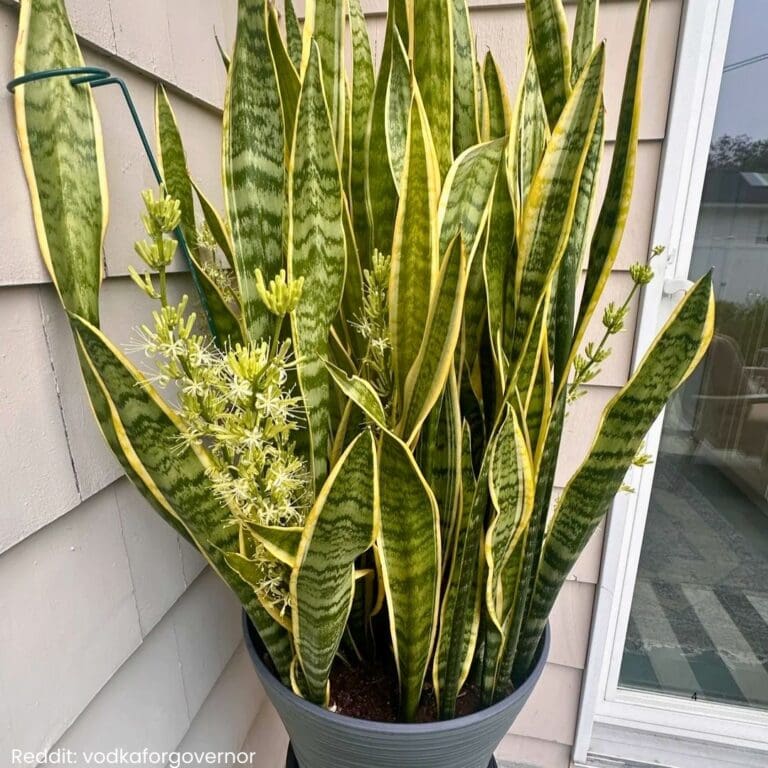
Very helpful Info. I have not had a good result with my plant and l am hopeful all your info will help. Thank you
Glad i could help!
I had a spider plant, that had 10 generations of pups. It was a beautiful plant, I won several first place ribbons. I lost it when I got cancer I tried to take in the hospital with me no chance, I have a new one it’s growing like crazy.
Thank you, for the great information.
I am glad i could help!
Thank you for all the information you put out on the spider plant I think it’s really really detailed. God bless you and your family 🙏🤗
Thanks for your kind words!
I have a variegated spider plant it’s growing but I have some purple spots on some leaves ,Why??
Hi your blog is very informative however you do not mention when repotting placing grit or stones to the bottom of the pot for drainage.
Last year I planted a few baby pups plants in small pots without drainage holes. I often accidentally over watered them so that were sitting in slot of water however they survived & are looking healthy